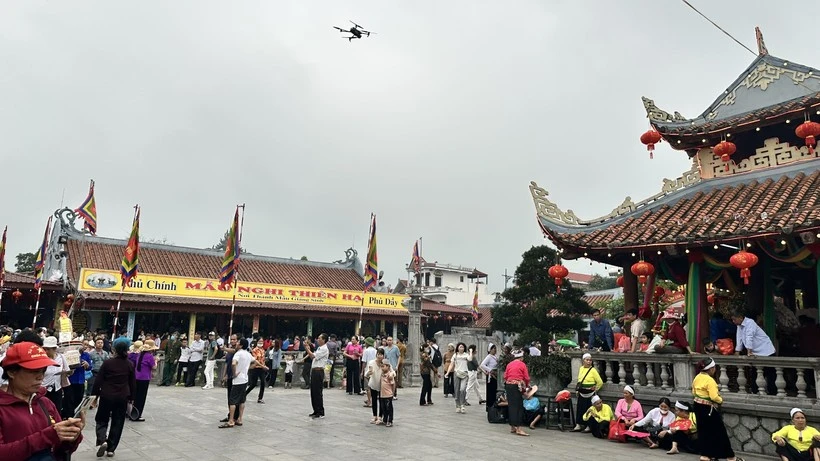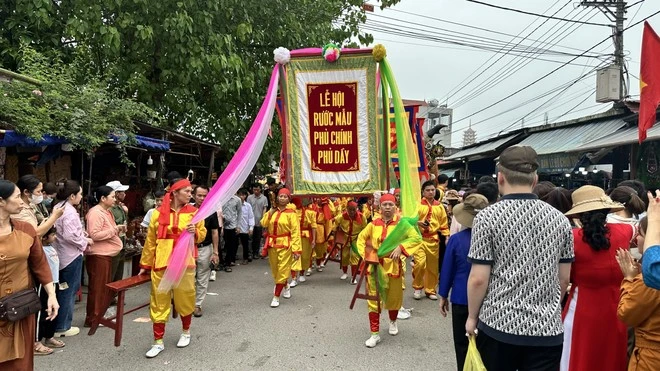Lieu Hanh - Supreme Mother Goddess in Vietnamese culture
In Vietnamese people’s belief of worshipping the Mother Goddesses, Mau Lieu Hanh (Mother Goddess Lieu Hanh) is the supreme spirit at the top of the pantheon. Lieu Hanh is also the only female figure in the “Tu Bat Tu” (Four Immortals) of Vietnamese people in the Red River Delta.

Visitors flocking to Phu Day Festival in Tien Huong Temple in 2024 (Photo: VietnamPlus)
In the thoughts of Vietnamese people, while the eighth lunar month is for commemoration of the “Father”, Duc Thanh Tran (Saint Tran), the third month is to remember the “Mother”, Goddess Lieu Hanh.
In the Worship of Mother Goddesses, she is worshipped as the Supreme Mother Goddess or the First Mother of Heaven’s incarnation, who sits in the middle of Three Altar Thrones.
The northern province of Nam Dinh is the host of the festivals to commemorate Duc Thanh Tran and Mau Lieu Hanh.
This year, the death anniversary of Mau Lieu Hanh took place from April 11-16, or the third to the eighth days of the third lunar month at the complex of Phu Day cultural and historical relic sites in Kim Thai commune of Vu Ban district, with various traditional rituals.

The procession of the Mother Goddess from Phu Day Temple to Tien Huong Pagoda (Photo: VietnamPlus)
According to legend, Lieu Hanh was the second daughter of the Jade Emperor, named Quynh Hoa. She broke her father's treasured cup and was banished to earth, and lived as a human being three times.
In all the three times living as a human being, she travelled to many places and helped people with good deeds, and then became a Buddhist nun and then a Bodhisattva.
The complex of Phu Day cultural and historical relic sites in Nam Dinh is attached to the third life of Lieu Hanh and the second incarnation of Mother Goddess Lieu Hanh.
The Phu Day Festival pays tribute to the merits of Mother Goddess Lieu Hanh, which lasts for many days, featuring the customs, folk performing arts and aesthetics of the community, of which the most prominent are “Chau van” ceremonial singing and “Hau dong” medium ritual.

“Hau dong” is the major ritual and the core of the Worship of Mother Goddesses at the Phu Day Festival (Photo: VNA)
The unique “Hau dong” ritual, which has been honoured by UNESCO as an Intangible Cultural Heritage of Humanity, is an intangible cultural heritage that synthesises many values of various types of folk culture such as oral beliefs, performances, music, literature, dance, mime, and fine arts.
Culture researchers affirmed that the Phu Day Festival is an important component of the “great demonstration of Lieu Hanh's epic”.
The complex of Phu Day cultural and historical relic sites consists of nearly 20 temples, palaces, pagodas and mausoleums, spanning nearly 10km, with a history and culture of hundreds of years. Of which, three national cultural and historical relic sites are dedicated to the Mother Goddess Lieu Hanh.
With its outstanding cultural, historical, artistic and architectural values, the complex of Phu Day cultural and historical relic sites was recognised as a national-level one. The Phu Day Festival and Chau Van ceremonial singing of Vietnamese people were also listed as national intangible cultural heritages.
In 2016, UNESCO honoured the Worship of Mother Goddesses of Vietnamese people as an Intangible Cultural Heritage of Humanity. The Phu Day Festival has become a national festival and a popular spiritual tourist destination for domestic and international visitors./.
VNA

